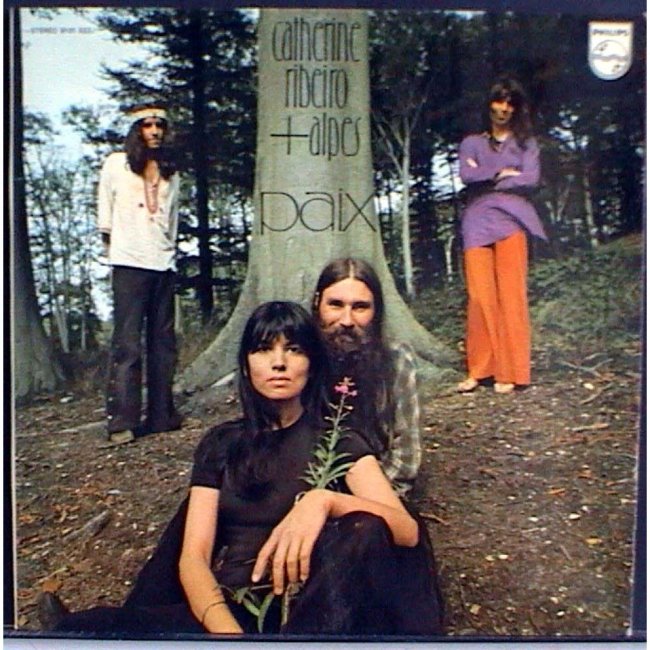Tags
CATHERINE RIBEIRO+ALPES— PAIX
The strength of Catherine Ribeiro+Alpes’ exceptional debut album, “No. 2” caught the attention of Philips Records, who quickly signed the group in 1971. For the next nine years Catherine Ribeiro+Alpes would wind up producing a total seven albums for the label, with an additional two solo albums by Ribeiro essaying the songs of Edith Piaf and Jacques Prevert.
Out of this prodigious output, it would be their second Philips LP “Paix” where their potential reached its highest level of realisation. Like nearly all of their albums, it featured a photo sleeve of the group outdoors somewhere in the Alpes de Haute Provence region of southern France, here situated in front of a great tree bearing their group name and album title as though carved directly into its trunk.
Catherine Ribeiro + Alpes were a French band formed in 1968. It consisted of singer and composer Catherine Ribeiro and guitarist Patrice Moullet. The other member changed through every record. The two used to be in the band Catherine Ribeiro + 2Bis, but decided to change the name after their first record. While their style was mostly folk and psychedelic rock in their first years, they also included elements of avant-garde into their music. Their lyrics dealt with mostly political and social issues, and they were all written by Catherine Ribeiro, who is also notable for her very special singing style, chaotic and expressive. They disbanded in 1981.
Here is a great write up of this wonderful wonderful album by Seth on Unsung blog:
Prior to this great channelling of dark majestic eddies came two tracks that offered no glimpse of the opaque complexities to follow. The most orthodox-sounding moment of the album comes with the introductory instrumental of “Roc Alpin.” An energetic and sunny fanfare, Ribeiro’s voice soars harmoniously throughout in wordless banners of “la-la-la-la-la-la”s that daisy chain the song while whipping optimistically under the bluest of skies. Moullet’s chiming cosmophone backs Lemoine’s organ until switching to squall throughout the bridge like a gust of fresh alpine air. The guest drumming of Michel Santangelli appears here alone on an album otherwise lacking in batterie and soon the sparse, arid and drum-less terrain Alpes had been recently traversing arrives with the concise “Jusqu’à Ce Que La Force Me Manqué.” A brimming heartful of balladeering, it laments and toils through both love’s many losses and triumphs. Where Ribeiro’s previous sequence of highly echoed “la-la-la-la-la-la”s had previously fluttered in the breeze, they now flap distressed under blustery psychic conditions while acoustic guitar and organ weave together in tight formation behind Ribeiro’s impassioned choral flights as though to keep her from ascending into the stratosphere.
Whereas the first two songs of the album contract and quickly pass, the remaining two expand into far more deliberate paces and hypnotic spaces as they veer into territory that can only be called progressive because it’s so entirely unique. The remainder of side one unfolds out into the first of two substantial epics in the form of the fifteen minute title track, “Paix.” One of Alpes’ all-time breathless moments of accomplishment, it combines lyrics of deep conscience into a drama of unending layers of twilight keyboards that repeat an ever-descending hymnal theme as consistent and cyclical as the tides. Percuphone agitates rhythmically in the distance to continually grow in prominence as linear swaths of Patrice Lemoine’s soothing Farfisa organ unfurl like mist into an opening theme echoed in brother Jean-Sebastien’s bass line. Oppressive, overcast clouds hang claustrophobically low while a second organ line scans for glimpses of possible, brighter futures. Moullet plucks notes out from his cradled cosmophone skeletally surf-like until a sudden shift upwards in tempo cause the rhythms of palpitating heartbeats to modulate into a full-tilt gallop. The bass doubles up to buttress the ensuing hyperspaced conical helix when Patrice Lemoine steps out with a veering wasp swarm of an organ solo not unlike Michael Ratledge’s coda on Kevin Ayers’ “Song For Insane Times.” The bass keeps steadily at it while the percuphone percolates, the cosmophone undulates and the once snarling organ degenerates back into the layered background pillow of winds and clouds. A spellbinding dream-zone ensues from this calm, an ever-building evolution while the percuphone’s telegraphic repetition runs unabated in the background in sombre reticulation. The motorised reports continue to click off steadily on its predetermined path of percolations, allowing all the space in the world for the rest of the ensemble to build through the volition of their own momentum. Suddenly, Ribeiro cuts in with violent declamations that demand peace to ‘he who screams because he sees clearly,’ to the ‘great confusions of misery’ and to ‘he who searches/striking his head against the wall.’ The swelling organ sustains quietly behind her stabbing and defiant pronouncements like water surging fluently all around the rocky outcroppings of her husky vocals. A clutch of cosmophone notes pluck strategically twixt the loping, staggered bass lines that dance like mystery shadows behind Ribeiro until she terminates her recitation with consecutive protracted invocations of “PAAAAAIIIIIX!!!” It’s as though she’s just released a flock of doves at the edge of a dark ocean of uncertainty hoping against hope at least one will endure its tenuous flight to the other side. This signals the musicians to plunge once more into a whirlpool where an unexpected second fuzz/Leslie rotating speaker-steeped organ attack re-enters with labyrinthine careening to swamp the proceedings with another cantankerous and super-nasally solo. Some time later, it will dissipate into the ether to allow the recurring bass line to gain in strength and corral everything to pour back into the opening theme to unite with Ribeiro, who operatically and wordlessly wails a series of “OOOOOOOHH” and “AAAAAAHHH”s with the colouration of dashed hopes pulsing in those hearts long dulled but newly reawakened, breaking the waves of the layered keyboards that surround and propel her lamentations. A crescendo takes the track down to an exhaustive conclusion.
